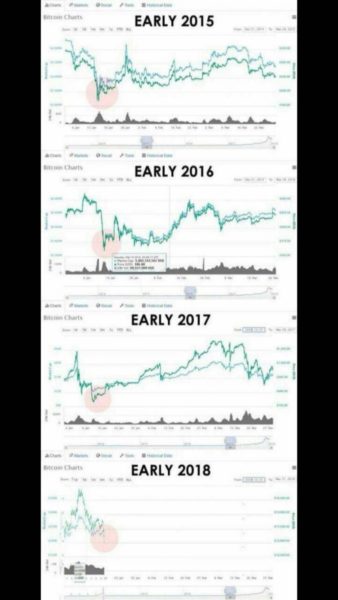CHINEESE NEW YEAR THE MAIN CAUSE OF BITCOIN CRASH!! DONT PANIC
A dramatic crash in the cryptocurrency market on Wednesday has been explained – not as a bubble bursting, but as an effect of Chinese New Year.
On Wednesday morning (AEDT), almost all the major cryptocurrencies mysteriously plummeted, with many losing more than 20 per cent of their value.
Bitcoin itself, current king of the cryptos, stabilised at 17 per cent below what it was the day before, and almost 50 per cent down from its December high of more than $25,000 ($US20,000).
Other major altcoins, including ethereum, ripple, dogecoin, litecoin and monero, were all down, many losing well over 20 per cent.
The plunge followed no obvious trigger, prompting theories to fly over what may have caused it. Crypto-sceptics immediately jumped on the plunge as evidence that the recent boom was a bubble that had burst.
Others pointed to the threat of greater regulation in South Korea and China.
But a more intriguing explanation is seen in the following graph, circulated on a cryptocurrency WhatsApp group on Wednesday, that shows a similar crash occurs at the same time every year.
While the graph is unsourced, this interactive chart confirms bitcoin has uniformly dipped in mid-January every year since 2014.
Jason Lee, global director for partnerships & strategic alliances at blockchain technology platform NEM, said while it was “hard to say” for sure what caused this trend, Chinese New Year, which falls in mid-February, almost certainly had something to do with it.
“In Chinese New Year, people make a lot of purchases in the lead-up, and then over New Year itself they stop spending. So a lot of the spending happens in the month before New Year,” he said.
In other words, Chinese people were cashing in their bitcoin gains to pay for the holiday excesses.
Armand Aguillon, a Gold Coast-based cryptocurrency investor, agreed.
“Around about January time there’s always a dip, and then it goes up again,” he told The New Daily.
“There’s a lot of Chinese players in the [cryptocurrency] space. At Chinese New Year, some people are selling off to buy what they need to buy [for the holiday].”
But both Mr Aguillon and Mr Lee agreed other factors were also at play in Wednesday’s crash. They cited the South Korean government’s plan to ban cryptocurrency exchanges, as well as the Chinese government’s hints it would outlaw cryptocurrency mining.
Mr Lee said he had been contacted by Chinese miners looking to move their operations out of China.
“So it’s FUD – fear, uncertainty, and doubt. That’s becoming a common term in the cryptocurrency world,” he said.
Mr Aguillon, meanwhile, said the expiry date of the first bitcoin futures was approaching, which may also go towards explaining the sell-off.
As an investor, he said he saw Wednesday’s crash as a temporary thing, and a good opportunity to buy cryptocurrencies.
The ripple effect
Among the cryptocurrencies to take a hit on Wednesday was ripple, which by 5pm was down 13.5 per cent – having recovered some of its earlier losses.
Ripple has become a favourite among more conservative crypto investors because it has connections to big established banks, including Westpac.
The New Daily asked Westpac whether the extreme volatility seen on Wednesday was a problem for the bank.
A spokesperson for Westpac said the bank was not exposed to the ripple cryptocurrency; rather, it had tested a means of international transfer using the Ripple platform, not the currency itself.
“Ripple has built a network of 100 banks via RippleNet to trial the possibility of sending money overseas using distributed ledger technology. This service has no exposure to trading in Ripple’s digital currency XRP,” the spokesperson said.